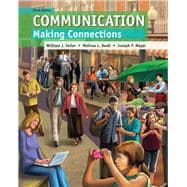
Note: Supplemental materials are not guaranteed with Rental or Used book purchases.
Purchase Benefits
What is included with this book?
In this Section:
1) Brief Table of Contents
2) Full Table of Contents
1) Brief Table of Contents
Chapter 1: Connecting Process and Principles
Chapter 2: Connecting Perceptions and Communication
Chapter 3: Connecting Self and Communication
Chapter 4: Connecting Through Verbal Communication
Chapter 5: Connecting Through Nonverbal Communication
Chapter 6: Connecting Listening and Thinking in the Communication Process
Chapter 7: Choosing a Topic and Connecting to the Audience
Chapter 8: Research: Gathering and Using Information
Chapter 9: Organizing and Outlining
Chapter 10: Managing Anxiety and Delivering Your Speech
Chapter 11: Informative Speaking
Chapter 12: Persuasive Speaking
Chapter 13: Interpersonal communication: A Theoretical Foundation
Chapter 14: Developing And Maintaining Relationships: From Formation To Dissolution
Chapter 15: Group and Team Communication
Chapter 16: Participating in Groups and Teams
2) Full Table of Contents
Chapter 1: Connecting Process and Principles
Communication: Making Connections
What is Communication?
Why Should We Study Communication?
Principles of Communication
Essential Components of Communication
Types of Communication
Distinguishing Social Media from Face-to-Face Communication
Misconceptions about Communication
Improving Communication Competence
Summary
Discussion Starters
Chapter 2: Connecting Perceptions and Communication
Perception and Communication
The Perception Process
Perceptual Differences
Improving Perception Competencies and Perception Checking
Summary
Discussion Starters
Chapter 3: Connecting Self and Communication
Understanding Self-Concept
Culture and Self-Concept
Gender and Self-Concept
Self-Fulfilling Prophecy and Impression Management
Enhancing Self-Concept
Summary
Discussion Starters
Chapter 4: Connecting Through Verbal Communication
The Importance of Language
The Elements of Language
Language-Based Barriers to Communication
Language and Technology
How to Use Language Effectively
Summary
Discussion Starter
Chapter 5: Connecting Through Nonverbal Communication
Making Everyday Connections
What is Nonverbal Communication?
Characteristics of Nonverbal Communication
Functions of Nonverbal Communication
Types of Nonverbal Communication
Improving Our Ability to Send and Interpret Nonverbal Communication
Summary
Discussion Starters
Chapter 6: Connecting Listening and Thinking in the Communication Process
The Importance of Effective Listening
Effective Listening
The Functions of Listening
Barriers to Effective Listening
Critical Listening and Critical Thinking: Analyzing and Evaluating Messages
Improving Listening Competence
Listening and Technology
Intercultural Listening
Summary
Discussion Starters
Chapter 7: Choosing a Topic and Connecting to the Audience
Selecting a Speech Topic
Determining the General Purpose, Specific Purpose, and Thesis of a Speech
Audience Analysis: Connecting with the Listeners
Summary
Discussion Starters
Notes
Chapter 8: Research: Gathering and Using Information
Research: Gathering Information
Using Research to Support and Clarify Ideas
Summary
Discussion Starters
Chapter 9: Organizing and Outlining
Organize the Body of Your Speech
Organize the Introduction of Your Speech
Organize the Conclusion of Your Speech
Outline Your Speech
Guidelines Using Presentational Note Cards
Sample Presentational Outline for an Informative Speech
Summary
Discussion Starters
References
Chapter 10: Managing Anxiety and Delivering Your Speech
Managing Speech Anxiety
Methods of Delivery
Vocal and Physical Aspects of Delivery
Presentational aids
Presentation Software
Practice Your Delivery
Summary
Discussion Starters
Chapter 11: Informative Speaking
Information and Power
Distinctions between Informative and Persuasive Speaking
Topics for Informative Speeches
Preparing and Developing an Informative Speech
Evaluating the Informative Speech
A Sample Informative Speech with Commentary
Summary
Discussion Starters
Appendix: Informative Speech Topics
Chapter 12: Persuasive Speaking
The Goal of Persuasive Speaking
Topics for Persuasive Speeches
Persuasive Claims
Establishing Credibility (Ethos)
Preparing and Developing a Persuasive Speech
Fallacies in Argument Development
Evaluating the Persuasive Speech
Sample Persuasive Speech with Commentary
Chapter 13: Interpersonal communication: A Theoretical Foundation
Connecting with Others via Interpersonal Communication
Theories of Interpersonal Communication
Self-Disclosure in Relationships
Summary
Discussion Starters
Chapter 14: Developing And Maintaining Relationships: From Formation To Dissolution
Interpersonal Communication Competence
Relationship Formation
Relationship Dissolution
Signs That Show a Relationship is in Trouble
Interpersonal Conflict
Improving Communication Competence in Relationships
Summary
Discussion Starters
Chapter 15: Group and Team Communication
Small-Group Communication: Making the Connection
Purposes and Types of Groups
Establishing a Group Culture
Characteristics of Small Groups
Ethical Behavior in Group Communication
Disadvantages of Small Groups
Summary
Discussion Starters
Chapter 16: Participating in Groups and Teams
Team Building
Leadership
Conducting a Meeting
Member Participation
Problem Solving and Decision Making
Managing Group Conflict
Evaluating Small Group Performance
Summary
Discussion Starters
Appendix
The New copy of this book will include any supplemental materials advertised. Please check the title of the book to determine if it should include any access cards, study guides, lab manuals, CDs, etc.
The Used, Rental and eBook copies of this book are not guaranteed to include any supplemental materials. Typically, only the book itself is included. This is true even if the title states it includes any access cards, study guides, lab manuals, CDs, etc.